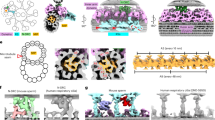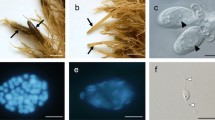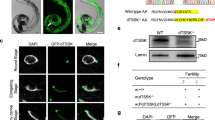Abstract
THE DNA-associated protein of the animal spermatozoon customarily undergoes two major changes in the course of differentiation of this cell during spermato-genesis. These changes, as have been established in a variety of organisms, are cytochemically delineable by the alkaline-fast-green, picric acid-bromophenol blue, and ammoniacal-silver staining methods1–4, when used in conjunction with the procedures of deamination and acetylation5–7. The first of these changes relates to the replacement of a lysine-rich histone by one rich in arginine in the spermatid stage of development of the spermatozoon, and the second change reflects the acquisition of protamine in place of the arginine-rich histone by the maturing spermatozoon. In Drosophila melanogaster however, there is observed only the first of these protein transformations8,9, and this occurs, according to our observations, at the terminal stages of spermiogenesis, shortly before eclosion of the fly (within 24 h or so at 29° C); that is, the time of the arginine-histone shift during sperm development in D. melanogaster coincides with the second stage of these chemical alterations in some other organisms, and there is no subsequent change to protamine in the mature spermatozoon.
This is a preview of subscription content, access via your institution
Access options
Subscribe to this journal
Receive 51 print issues and online access
$199.00 per year
only $3.90 per issue
Buy this article
- Purchase on Springer Link
- Instant access to full article PDF
Prices may be subject to local taxes which are calculated during checkout
Similar content being viewed by others
References
Alfert, M., and Geschwind, I. I., Proc. U.S. Nat. Acad. Sci., 39, 991 (1953).
Bloch, D. P., and Hew, H. Y. C., J. Biophys. Biochem. Cytol., 7, 515 (1960).
Bloch, D. P., and Hew, H. Y. C., J. Biophys. Biochem. Cytol., 8, 69 (1960).
Black, M. M., and Ansley, H. R., Science, 143, 693 (1964).
Van Slyke, D. D., Biol. Chem., 9, 185 (1911).
Olcott, H. S., and Fraenkel-Conrat, H., Chem. Rev., 41, 151 (1947).
Monné, L., and Slautterback, D. B., Ark. Zool., 1, 455 (1950).
Das, C. C., Kaufmann, B. P., and Gay, H., Abstr. Second Ann. Meeting Amer. Soc. Cell. Biol., 39 (1962).
Das, C. C., Kaufmann, B. P., and Gay, H., Exp. Cell Res., 35, 507 (1964).
Allfrey, V. G., Mirsky, A. E., and Osawa, S., J. Gen. Physiol., 40, 451 (1957).
Kaufmann, B. P., and Gay, H., in Repair from Genetic Radiation Damage, edit. by Sobels, F. H., 375 (Pergamon Press, Oxford).
Bloch, D. P., and Brack, S. D., J. Cell Biol., 22, 327 (1964).
Author information
Authors and Affiliations
Rights and permissions
About this article
Cite this article
DAS, C., KAUFMANN, B. & GAY, H. Autoradiographic Evidence of Synthesis of an Arginine-rich Histone during Spermiogenesis in Drosophila melanogaster. Nature 204, 1008–1009 (1964). https://doi.org/10.1038/2041008a0
Issue Date:
DOI: https://doi.org/10.1038/2041008a0
This article is cited by
-
Arginine-rich nucleoprotein transition occurs in the two size classes of spermatozoa of Drosophila subobscura males
Genetica (1983)
-
Nature et �volution des prot�ines basiques au cours de la spermiogen�se chez Pleurodeles waltlii Michah., Amphibien urod�le
Histochemie (1970)
-
Developmental features and synthetic patterns of male germ cells ofUrechis caupo
Wilhelm Roux' Archiv f�r Entwicklungsmechanik der Organismen (1968)
Comments
By submitting a comment you agree to abide by our Terms and Community Guidelines. If you find something abusive or that does not comply with our terms or guidelines please flag it as inappropriate.



